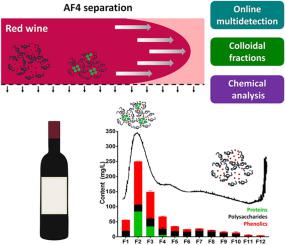当前位置:
X-MOL 学术
›
Food Hydrocoll.
›
论文详情
Our official English website, www.x-mol.net, welcomes your
feedback! (Note: you will need to create a separate account there.)
Characterization of red wine native colloids by asymmetrical flow field-flow fractionation with online multidetection
Food Hydrocolloids ( IF 11.0 ) Pub Date : 2021-01-01 , DOI: 10.1016/j.foodhyd.2020.106204 Valentina Marassi , Matteo Marangon , Andrea Zattoni , Simone Vincenzi , Andrea Versari , Pierluigi Reschiglian , Barbara Roda , Andrea Curioni
Food Hydrocolloids ( IF 11.0 ) Pub Date : 2021-01-01 , DOI: 10.1016/j.foodhyd.2020.106204 Valentina Marassi , Matteo Marangon , Andrea Zattoni , Simone Vincenzi , Andrea Versari , Pierluigi Reschiglian , Barbara Roda , Andrea Curioni

|
Abstract Colloids are an important component of wines, but their study is challenging due to their instability. Asymmetrical Flow-Field Flow Fractionation (AF4)-multidetection is here proposed as a suitable approach to isolate and characterize red wine colloids in native state. AF4 provided size-separation and enabled quantification of the colloidal content of two wines. The gyration radius of colloids was determined by multi-angle light scattering, and ranged between 25 and 50 nm. Analysis of the collected AF4-fractions showed that proteins, polysaccharides and phenolics were present in different proportions among fractions. The composition of AF4-fractions differed between wines. SDS-PAGE analysis of AF4-fractions indicated the presence of protein-phenolics sub-aggregates only in the fractions containing colloids with small radius. The results allowed proposing a model for red wine colloids structure, which comprises two coexisting entities, one made of covalently linked proteins-phenolics sub-aggregates interacting by non-covalent forces with polysaccharides, and a second in which only polysaccharides and phenolics are present. The proposed model is consistent with the reported relative stability of red wine proteins, a fact that can be due to the stabilizing activity of polysaccharides. Given that enological practices affect the extraction of proteins, polysaccharides and phenolics, AF4-technique represents a very promising tool to investigate the effects of these practices on wine colloidal aggregation and behavior.
中文翻译:

通过在线多重检测的非对称流场-流分馏表征红酒天然胶体
摘要 胶体是葡萄酒的重要组成部分,但由于其不稳定性,对其研究具有挑战性。此处提出了不对称流场流分馏 (AF4)-多重检测作为分离和表征天然状态的红酒胶体的合适方法。AF4 提供大小分离并能够定量两种葡萄酒的胶体含量。胶体的回转半径由多角度光散射测定,范围在 25 至 50 nm 之间。对收集的 AF4 级分的分析表明,蛋白质、多糖和酚类物质以不同比例存在于各级分中。AF4 级分的组成因葡萄酒而异。AF4 级分的 SDS-PAGE 分析表明仅在含有小半径胶体的级分中存在蛋白质-酚类亚聚集体。结果允许提出红葡萄酒胶体结构模型,该模型包含两个共存实体,一个由共价连接的蛋白质 - 酚类亚聚集体通过非共价力与多糖相互作用制成,第二个仅存在多糖和酚类。所提出的模型与报道的红酒蛋白质的相对稳定性一致,这一事实可能是由于多糖的稳定活性。鉴于酿酒实践会影响蛋白质、多糖和酚类物质的提取,AF4 技术代表了一种非常有前途的工具,可以研究这些实践对葡萄酒胶体聚集和行为的影响。一种由共价连接的蛋白质 - 酚类亚聚集体通过非共价力与多糖相互作用制成,另一种只存在多糖和酚类物质。所提出的模型与报道的红酒蛋白质的相对稳定性一致,这一事实可能是由于多糖的稳定活性。鉴于酿酒实践会影响蛋白质、多糖和酚类物质的提取,AF4 技术代表了一种非常有前途的工具,可以研究这些实践对葡萄酒胶体聚集和行为的影响。一种由共价连接的蛋白质 - 酚类亚聚集体通过非共价力与多糖相互作用制成,另一种只存在多糖和酚类物质。所提出的模型与报道的红酒蛋白质的相对稳定性一致,这一事实可能是由于多糖的稳定活性。鉴于酿酒实践会影响蛋白质、多糖和酚类物质的提取,AF4 技术代表了一种非常有前途的工具,可以研究这些实践对葡萄酒胶体聚集和行为的影响。这可能是由于多糖的稳定活性。鉴于酿酒实践会影响蛋白质、多糖和酚类物质的提取,AF4 技术代表了一种非常有前途的工具,可以研究这些实践对葡萄酒胶体聚集和行为的影响。这可能是由于多糖的稳定活性。鉴于酿酒实践会影响蛋白质、多糖和酚类物质的提取,AF4 技术代表了一种非常有前途的工具,可以研究这些实践对葡萄酒胶体聚集和行为的影响。
更新日期:2021-01-01
中文翻译:

通过在线多重检测的非对称流场-流分馏表征红酒天然胶体
摘要 胶体是葡萄酒的重要组成部分,但由于其不稳定性,对其研究具有挑战性。此处提出了不对称流场流分馏 (AF4)-多重检测作为分离和表征天然状态的红酒胶体的合适方法。AF4 提供大小分离并能够定量两种葡萄酒的胶体含量。胶体的回转半径由多角度光散射测定,范围在 25 至 50 nm 之间。对收集的 AF4 级分的分析表明,蛋白质、多糖和酚类物质以不同比例存在于各级分中。AF4 级分的组成因葡萄酒而异。AF4 级分的 SDS-PAGE 分析表明仅在含有小半径胶体的级分中存在蛋白质-酚类亚聚集体。结果允许提出红葡萄酒胶体结构模型,该模型包含两个共存实体,一个由共价连接的蛋白质 - 酚类亚聚集体通过非共价力与多糖相互作用制成,第二个仅存在多糖和酚类。所提出的模型与报道的红酒蛋白质的相对稳定性一致,这一事实可能是由于多糖的稳定活性。鉴于酿酒实践会影响蛋白质、多糖和酚类物质的提取,AF4 技术代表了一种非常有前途的工具,可以研究这些实践对葡萄酒胶体聚集和行为的影响。一种由共价连接的蛋白质 - 酚类亚聚集体通过非共价力与多糖相互作用制成,另一种只存在多糖和酚类物质。所提出的模型与报道的红酒蛋白质的相对稳定性一致,这一事实可能是由于多糖的稳定活性。鉴于酿酒实践会影响蛋白质、多糖和酚类物质的提取,AF4 技术代表了一种非常有前途的工具,可以研究这些实践对葡萄酒胶体聚集和行为的影响。一种由共价连接的蛋白质 - 酚类亚聚集体通过非共价力与多糖相互作用制成,另一种只存在多糖和酚类物质。所提出的模型与报道的红酒蛋白质的相对稳定性一致,这一事实可能是由于多糖的稳定活性。鉴于酿酒实践会影响蛋白质、多糖和酚类物质的提取,AF4 技术代表了一种非常有前途的工具,可以研究这些实践对葡萄酒胶体聚集和行为的影响。这可能是由于多糖的稳定活性。鉴于酿酒实践会影响蛋白质、多糖和酚类物质的提取,AF4 技术代表了一种非常有前途的工具,可以研究这些实践对葡萄酒胶体聚集和行为的影响。这可能是由于多糖的稳定活性。鉴于酿酒实践会影响蛋白质、多糖和酚类物质的提取,AF4 技术代表了一种非常有前途的工具,可以研究这些实践对葡萄酒胶体聚集和行为的影响。











































 京公网安备 11010802027423号
京公网安备 11010802027423号